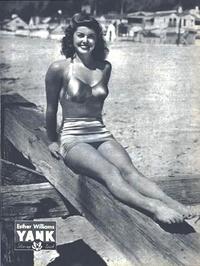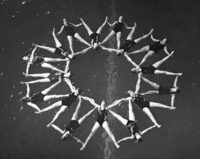The Coen brother's newest film, Hail, Caesar! channels the glamour of the Golden-era "aquamusical," the splashy, pool-centric musical genre made popular by Esther Williams in the 1940s and early 1950s. In one of the film's movie-within-a-movie subplots, Scarlett Johansson plays a sequined Hollywood mermaid starring in an Esther Williams-style aquamusical with daring high dives, spouting water fountains, and aerial shots of synchronized swimmers in shifting, geometric patterns reminiscent of those directed by celebrated choreographer Busby Berkeley.
Now a kitschy remnant of a bygone era, the aquamusical was spectacularly successful during its midcentury heyday when Esther Williams starred in more than twenty water-themed MGM films and became one of the top actresses in Hollywood. By Williams' own admission, her films lacked critical acclaim and the plotlines were recycled (Girl swims; boy falls in love.), and yet they struck a chord with post-World War II audiences for several reasons:
1. Esther Williams -- America's Mermaid
When MGM set out to find a swimming starlet who could do for MGM musicals what Norwegian skating sensation Sonja Henie had done for Fox--only in the water instead of on it, Williams had it all: a dynamite mix of sex appeal and girl-next-door charm, mile-high legs and a megawatt smile, and "all-American" good looks and diction that lacked any trace of ethnic roots or regional accent.
 Williams also knew how to make swimming look good...and look good swimming. A breaststroke and freestyle champion whose Olympic hopes were dashed when the 1940 games were cancelled due to World War II, Williams instead became the headliner for Billy Rose's Aquacade in San Francisco. At the Aquacade, Williams learned to "swim pretty,"--Rose's term for moving gracefully through the water with head and shoulders held high--and was spotted by an MGM talent scout who recruited her to the studio.
Williams also knew how to make swimming look good...and look good swimming. A breaststroke and freestyle champion whose Olympic hopes were dashed when the 1940 games were cancelled due to World War II, Williams instead became the headliner for Billy Rose's Aquacade in San Francisco. At the Aquacade, Williams learned to "swim pretty,"--Rose's term for moving gracefully through the water with head and shoulders held high--and was spotted by an MGM talent scout who recruited her to the studio.
MGM ran Williams through its star-making machine, circulating her pinup to Yank and other military magazines and sending her on goodwill missions to entertain wounded troops. By the time she made her first on-screen appearance, Williams was already well on her way to becoming America's Mermaid.
2. Technicolor Escape
Although Technicolor was introduced much earlier, it wasn't widely used in Hollywood films until the 1940s. The vivid, aquamarine colors of Williams' movies became the perfect showcase for the new technology and served as escapist salve for the war-weary eyes of the public. Depression-era audiences had been dazzled by Berkeley's black-and-white synchronized dream sequences, but seeing his work--he directed many of Williams' water ballet scenes--in better-than-real-life colors and a Kodachrome Williams gliding through bright turquoise waters provided Americans reeling from World War II with a neoteric escape.
3. Legs!
In an era of Hollywood self-censorship, Williams' aquamusicals showed no shortage of skin. MGM used chaste plot lines and capitalized on the association between wholesomeness and  swimming --painstakingly established earlier in the century by women's sports advocates--to evade the Production Code Administration, even as they displayed wet, barely-dressed female bodies on screen. Just as Fox had gotten away with Sonja Henie's short skirts as the uniform of her sport, MGM reminded audiences of Williams' swimming chops as they paraded her in a bathing suit at every possible opportunity. In Williams' autobiography, she recalls how her white negligee in Texas Carnival passed censors only because she wore it in the water and not on land.
swimming --painstakingly established earlier in the century by women's sports advocates--to evade the Production Code Administration, even as they displayed wet, barely-dressed female bodies on screen. Just as Fox had gotten away with Sonja Henie's short skirts as the uniform of her sport, MGM reminded audiences of Williams' swimming chops as they paraded her in a bathing suit at every possible opportunity. In Williams' autobiography, she recalls how her white negligee in Texas Carnival passed censors only because she wore it in the water and not on land.
4. The Rosie-the-Riveter Effect
With ideas about women in the workforce and gender roles shifting after the war, aspects of Williams' films appealed to new conceptions of the "modern woman." Unlike the wispy starlets of the talkies, Williams, who was tall and athletic with visible muscles, was usually depicted as the physical equal of her on-screen love interests. And though her roles wouldn't be considered feminist by today's standards, her career-minded characters often postponed love and marriage until after they had realized their own dreams. The swimmer she portrayed in Dangerous When Wet rejects the advances of a seductive Frenchman while in training to cross the English Channel. Of course she promptly marries him after she attains her goal, but at least she keeps her eyes on the prize for most of the movie.
5. The Rise of Synchronized Swimming
Esther Williams didn't invent synchronized swimming, but she did glamorize a rising sport and bring it to a wider audience. Synchronized swimming--then commonly called "water ballet"--was immensely popular in the 1940s and 1950s, a time when few other athletic opportunities existed for women. National surveys from the era estimated that more than sixty percent of colleges and universities offered synchronized swimming clubs or teams. 
The sport has changed drastically in the past sixty years, becoming ever higher, faster, stronger as it has secured its Olympic standing, but the Coen brothers stayed true to the water-ballet style of the 1940s aquamusical. Performed by the retro-mod Aqualilies, the synchronized swimming in Hail, Caesar! steers clear of tight throws, flips, and upside hybrids--hallmarks of the sport today--in favor of fluid movements and kaleidoscopic float patterns. For an extra dollop of nostalgia, the water scenes in Hail, Caesar! were filmed in the same ninety-by-ninety foot tank Esther Williams swam in throughout her career at MGM.
Decline of a Genre
By the late 1950s, musicals were on their way out, audiences were no longer titillated by the sight of swimsuited women, the home-pool craze had dulled the sheen of exoticism that swimming pools once held, and America's Mermaid was getting older. After Williams left MGM in 1956, the studio stopped making aquamusicals. As a result, the genre didn't evolve as the world turned on its head in the 1960s, but instead froze in time just as it was, making its films into instant classics.
Much more than a caricature of an era, the aquamusical was a genuine--albeit a micro-cosmic, candy-coated--product of its time worthy of its reappearance in the Coen brothers' homage to Hollywood's Golden Age.